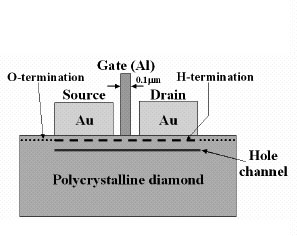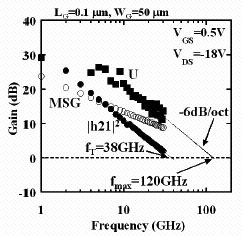@
Kenji Ueda and Makoto Kasu
Materials Science Laboratory
@Diamond is expected to be the most suitable material for high-power high-frequency
electronic devices because of its high electric breakdown field (>10
MV/cm), high carrier mobility (4500 cm2/Vs for electrons, 3800 cm2/Vs for holes), and highest thermal conductivity (22 W/cmK). Recently,
using homoepitaxial single-crystal CVD diamond, we achieved the maximum
output-power density of 2.1 W/mm at 1 GHz [1], which is high enough for
power amplifiers of the base stations in wireless communications systems.
However, the size of single-crystal CVD diamond is limited to 4 mm, which
is the size of commercially available HPHT-synthesized diamond substrates.
From the viewpoint of semiconductor-device processing, at least four-inch
wafers are needed. One possible solution to this problem is to use
high-quality polycrystalline diamond, whose maximum size is 4 inches.
Here, using a high-quality polycrystalline diamond film, we report significant
progress in fabricating FETs. The grain size of the polycrystalline
film is `100Êm, which is comparable to our FET size. Thus, the
effect of the grain boundary seems to be very small.
@As shown in Fig. 1, the FETs were fabricated on the freestanding polycrystalline
diamond grown by CVD (size: 10 mm~10 mm~0.5 mm). The diamond surface
was passivated with hydrogen (H-passivation) to form a quasi two-dimensional
hole channel. The source and drain Au ohmic contacts were formed
on the H-terminated surface. Electron-beam lithography and self-alignment
techniques enabled us to form 0.1-mm-long Al Schottky gate contacts.
The DC characteristics show drain current (IDS) of 550 mA/mm at gate source voltage (VGS) of -3.5 V. The IDS is comparable to the maximum value of single-crystal CVD diamond FETs.
The DC transconductance (gm) stays high (`140 mS/mm) in a relatively wide VGS range. The transition frequency (fT) and maximum frequency of oscillation (fmax) were extracted from the frequency dependence of the
short circuit current gain (|h21|2) and the unilateral power gain (U) as shown in Fig. 2. The maximum
fmax is 120 GHz, and in a different bias condition, fT of 45 GHz was obtained. These fT and fmax values are the highest among diamond FETs [2].
[1] M. Kasu, K. Ueda, H. Ye,
Y. Yamauchi, et al., Electron. Lett. 41 (2005) 1249.
[2] K. Ueda, M. Kasu, Y. Yamauchi, et al., IEEE Electron Device Lett. 27 (2006) 570.
 |
 |
|||||
|
@@ |
|
||||